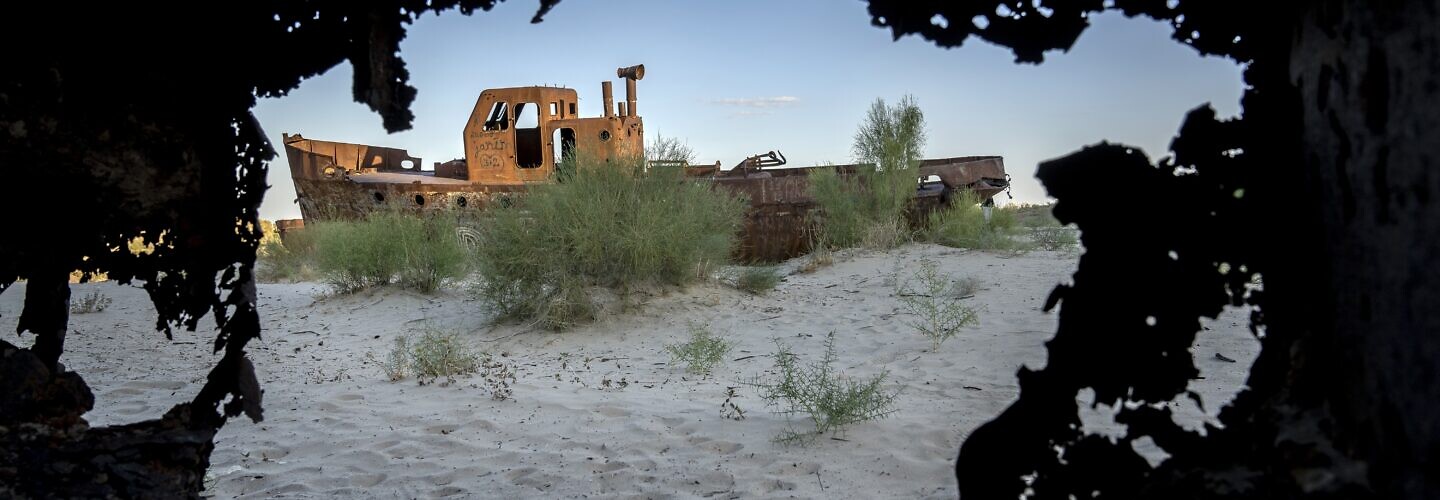A boat sits where the Aral Sea once was in Muynak, Uzbekistan, July 12, 2023. Today, the Aral has shrunk to less than a quarter of its former size. (AP Photo/Ebrahim Noroozi)
In September, the United Nations will convene a Summit of the Future, a “once in a generation opportunity” to reinvigorate global action, according to the UN Secretary-General. And as millions of respondents to the UN@75 survey in 2021 said, the “overwhelming priority” is the environment. More than 70% of people between the ages of 18-25 are extremely worried about climate change, and it has been listed as a top global threat across respected multi-country surveys. If the Summit of the Future is to be meaningful, it must deliver for the planet, including by generating resources for those regions most affected by climate change.
Yet in the General Assembly resolution laying out the scope of the Summit of the Future, the environment is conspicuously absent. Of the five “pillars” of the Summit, one pillar focuses on the Sustainable Development Goals (SDGs), but this is hardly a clear call for an ambitious environmental agenda. The recently finalized “zero draft” for the “Pact for the Future,” the Summit’s outcome document, contains many recommitments to existing environmental obligations (and the possibility of setting a date for the end of fossil fuel subsidies) but no big-ticket outcome.
This would be a strategic mistake. Not only would it ignore one of the clearest and most important issues driving global risks today, but it would mean the Summit would not resonate with the majority who see the environment as a top priority.
It is not too late for UN member states to generate a planetary narrative and outcome for the Summit. Some of the many steps they could take include:
Issue a Declaration of Planetary Emergency at the Summit of the Future. Of course, not all member states will agree to this, but getting a critical mass to sign on could create momentum and create a focal point for action. The Club of Rome has already put forward a viable and ambitious framework for such a declaration.
Commit to phasing out fossil fuels. Yes, COP28 fell short of this goal last year, but it is too important to wait for COP29, where it may fall short again. The Summit could hold a ministerial event where a critical mass of states committed to a time-bound end of fossil fuels. This could create significant pressure on other states to step up and add specificity to the language already in the draft Pact.
Double the G20 commitment on climate. Last year’s G20 meeting in India set a record for climate aid commitments, but it’s still a drop in the bucket in terms of what is needed. The Summit of the Future should include an event where the 2023 commitments are doubled, at a minimum. Building on last year’s Climate Ambition Summit, major companies should look to dramatically increase their investments in the green transition, and the World Bank should look to go beyond its current commitments on Paris alignment.
Align the global financial architecture with sustainability. The Summit has a dedicated track on the international financial architecture, which could be the most impactful arena for change at the global level. Specific commitments by the World Bank, International Monetary Fund, and regional development banks to tie their investments more directly to environmental outcomes could be a game changer. Other initiatives, like the Villars Framework on Trade Sustainability could help orient more of our global governance systems around incentivizing and accelerating a just, green transition.
Move beyond Gross Domestic Product. One of the most exciting ideas put forward by the Secretary-General last year was in his “Beyond GDP” policy brief. Today, our overriding emphasis on economic growth as the sole indicator of progress means we remain tied to unsustainable energy and development practices. Member states should consider how they might implement SDG 17.19, which calls for development of other indicators of progress. Tying these to a balance with our planet would be a major step forward and could be launched at the Summit.
Expand and strengthen the UN Environmental Programme. Today, the UN has three pillars: human rights, peace and security, and development. The environment is structurally subordinated to development and provided with a poorly resourced program in UNEP. Increasing UNEP’s capacities and mandate could generate important new understandings and action on our planetary emergency, and could be a commitment made at the Summit. The High-Level Advisory Board on Effective Multilateralism has offered a game plan for this in its report last year, including specific initiatives like a Science-Policy-Action Network for the planet that could be launched at the Summit. Other ambitious ideas could include the creation of a Global Environmental Agency or the recognition of the crime of ecocide.
Support the early appointment of an Envoy for Future Generations well before the Summit. Such a focal point could help to galvanize action on a range of environmental issues, be a mouthpiece for a sustainable future, and help to coalesce champions for specific initiatives. Could the envoy be appointed well before the Summit, allowing the Summit itself to become a forum where member states commit to resourcing her/his work, including around the environment?
These are just some of the ways member states can take meaningful action on the environment at the Summit of the Future. Not all of them will land on the first try, but they can generate a discussion about how to advance the environment in alignment with the urgent need to accelerate progress on the SDGs. One thing is clear: member states must deliver seriously on the environment for the Summit of the Future to be considered a success.
Adam Day is the Head of UN University Centre for Policy Research Geneva Office. The views expressed here are not necessarily those of UN University or the United Nations.





